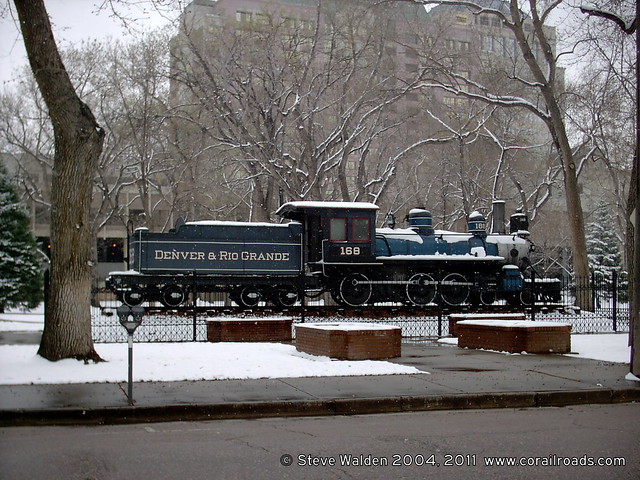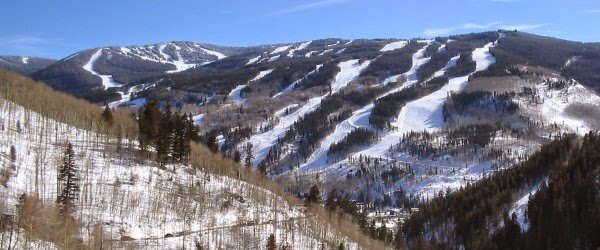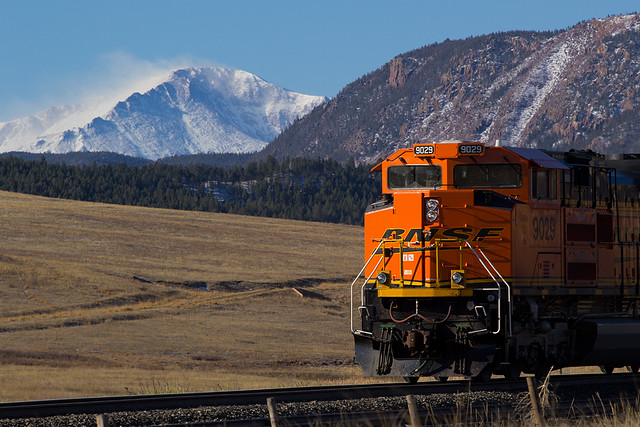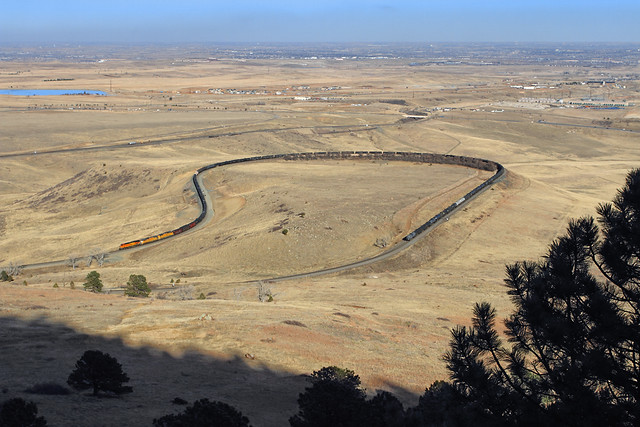On Monday evening, Walt Loevy caught the UP-led Ringling Bros, Barnum & Bailey circus train on it's way north through Monument on the west side of the grade with dusk approaching. Be warned: the flange noise on the curve is pretty loud! He catches up with it at Greenland, well after sunset for a final look. https://youtu.be/o9rn4klHKT8
By the way, the RBBX train--the longest privately owned train in the world--was featured on the single season of Extreme Trains. The hour long episode is here.◊
Saturday, June 13, 2015
Monday, April 20, 2015
Cumbres & Toltec Scenic Announces Lease To Fully Restore T-12 Engine 168
Colorado Springs City Council has approved a lease of D&RG 168 by the Cumbres & Toltec Scenic Railroad for the purpose of full restoration to steam. It was initially proposed to the city in October and surprisingly--Nathan Holmes of DRGW.net called it "a rare moment of sanity and agreement"--they accepted. The Cumbres & Toltec Scenic's eventual success in restoring D&RGW 463, one of two surviving Mudhens, probably influenced the council's decision.
The 168 is one of two surviving T-12 class narrow gauge ten-wheelers purchased by the Denver & Rio Grande Railroad in 1883 by Baldwin Locomotive Works in Philadelphia. The Rio Grande, having spent the previous two years in a frenzy of expansion needed a number of new narrow gauge locomotives to service the new lines. The other surviving engine, 169, rests in Alamosa, 30 miles north of the eastern terminus of the C&TS at Antonito.
The city will lease the locomotive to the railroad for 3 consecutive 15 year terms. This is inclusive of the time to take it apart and fully restore all parts that have corroded or wasted in the 77 years since it last saw service. The locomotive last saw a full cosmetic restoration completed in 1984 and has received periodic upkeep. As it has occupied the same location for nearly 8 decades, the locomotive's static display predates most buildings downtown.
Most of the buildings, that is, with the exception of the Colorado Springs D&RG Depot, located across the street from Antlers Park. The close proximity of two of the oldest artifacts of Colorado's most extensive railroad has often resulted in their pairing in presentation in promotional and tourism material. The depot had for years served as a restaurant until a change of ownership and subsequent mismanagement forced it to close in 2011.
It is one of the ideas that for many years I had dreamed might one day come about. Could the city that was founded by Gen. Palmer only a year after his "baby road" one day find a way to return to steaming operation a locomotive that had such a history and connection to the city? I once thought it impossible, considering the difficulties of other organizations and other cities. Now, ...who knows what's next?◊
* On a personal note, this was one of my first digital photographs since 1997.
 |
| Rio Grande 168 rests placidly under a thin blanket of snow on April 10, 2004. Photo by Steve Walden* |
 |
| Only a year after her presentation on Aug 27, 1939 (DPL) |
.jpg) |
| June 13, 1943 Same engine and city but can you spot all that's changed in less than 4 years? Both photos: Otto Perry (courtesy DPL) |
It is one of the ideas that for many years I had dreamed might one day come about. Could the city that was founded by Gen. Palmer only a year after his "baby road" one day find a way to return to steaming operation a locomotive that had such a history and connection to the city? I once thought it impossible, considering the difficulties of other organizations and other cities. Now, ...who knows what's next?◊
* On a personal note, this was one of my first digital photographs since 1997.
Tuesday, April 14, 2015
Ask the Editor: Can I Get From Vail to Denver Using Old Rails?
One of the first questions I received using the Ask the Editor form is from Tim S. of Sydney, Australia who asks,
Here's my answer,
"Is it possible to get from Vail to Denver using old rails?"
 |
| Vail ski area, photo by David Benbennick |
Hi Tim!If you have a question for the editor, please use the form in the near column or send an e-mail to editor@corailroads.com◊
Good to hear from you via the site! I'd be happy to answer your question and if I don't quite answer your question or you have follow-up questions, please let me know!
First, a qualification. You don't mention the means you'd be traveling so I'll be just talking routes, not actual access to travel the routes. Any properties as well as your legal access to them are yours to discover and arrange, meaning none of what I say should be taken as an endorsement to pursue any activity, legal or otherwise.
Colorado's main expansion and consolidation of railroads happened between 1872 and 1917. Skiing, Vail's reason for being, did exist in a primitive way toward the end of that period, but didn't take off until after WW2. Vail as a town isn't much older than I am, incorporated in 1966, the ski area having been there for since 1962. So, if there was ever rail service near Vail, it would have been by coincidence, not by design of serving Vail.
The route over Vail Pass is the most direct candidate for a rail route to Denver. But it was completed in 1940 when the original US 6 was pushed through to Utah on it's way from Massachusetts to California. The grades over Vail Pass, at present, would be pushing the limits of rail technology. It would be very difficult without changing the route or the design of conventional rail travel.
The other direction out of the Vail Valley comes out at where Gore Creek flows into the Eagle River which is followed by the Tennessee Pass Route of the Rio Grande, the railroad that inspired the graphics for Colorado Railroads. It would be possible to follow that route all the way over Tennessee Pass and down the Arkansas River to Pueblo. That route has been out of service since 1997 (18 years this fall). Pueblo to Denver has been in active rail service since 1872, or thereabout. At present, Union Pacific owns both routes, in whole for TP and in part for the Front Range.
If you are interested in older routes, or in narrow gauge railroads that served nearly all the towns except Vail, I can go into further detail.
Keep Exploring!
Steve
Tags:
abandoned right-of-way,
Ask the Editor,
Denver and Rio Grande Western,
history,
ski industry,
Tennessee Pass Route
Location:
Vail, CO, USA
Friday, April 10, 2015
POTD: Snowy Majesty From Greenland Ranch
Today we get a second shot from March 25 by Chris Paulhamus. When the weather is perfect like this, would you turn a second shot down? Taken an hour later than Monday's POTD, Chris notes that the wind has picked up a bit by blowing the heat shimmers across the center of the frame. Pikes Peak's east ridge remains in the clear. Had the auto focus been left unchecked, I wonder if we would be looking at the same picture.
While the loco is more maize than Armour (mustard) yellow because of the diesel grime accumulating on its nose, 4591's winged shield brings a bit of the wild blue down to the rails. The perfectly dead on shot is another great contrast, especially the organic horizontal lines compared to the SD70-M's rigid steel lines. The meridian of light and dark is also carried by the landscape, owing to the difference in altitude.
Even on it's own, weather differences can make for a startling contrast, especially in spring when warmth along the Front Range doesn't reach the snowy climes at altitude. For the next two months, a trip to Greenland and Douglas County Open Space might be worth it for the practice. For best results, go in the morning, and bring your tripod and your scanner!◊
 |
| Photo of the Day: Chris Paulhamus |
Even on it's own, weather differences can make for a startling contrast, especially in spring when warmth along the Front Range doesn't reach the snowy climes at altitude. For the next two months, a trip to Greenland and Douglas County Open Space might be worth it for the practice. For best results, go in the morning, and bring your tripod and your scanner!◊
Tags:
Chris Paulhamus,
Joint Line,
Photo Tips,
POTD,
Union Pacific
Location:
Douglas County, CO, USA
Last Minute Nudge Needed for Southwest Chief
ColoRail, the Colorado Rail Passenger Association, has requested the readers of Colorado Railroads help support a last minute effort to help preserve funding in Colorado's annual budget for rehabilitating the Southwest Chief. As many of you already know, Amtrak had been forced to look at re-routing the train mid route after BNSF reduced maintenance on its present route.
Now, with ColoRail, local communities, concerned citizens, more than one politician, and a TIGER on board, Amtrak says it will not re-route the train. Most importantly, this allows projects that had been put on hold in communities all along the line when they announced the possible re-route. This includes projects like La Junta's multimodal transportation hub. However, if Colorado is not able to come to the table with it's share, we may end up right back where we started.
So what's happened? Last night, Colorado's House of Representatives included the $1.5M needed in their budget for the year. Last week, the state Senate, by a vote of 17-18, failed to pass the request. What happens when the two bills don't match up? The 6 members of Joint Budget Committee meet in the next week to reconcile the differences between bills. If they go with the house version, Colorado makes it to the table with BNSF, Amtrak, Kansas and twelve SE Colorado communities that have all ponied up the funds to get back on track. If not, it puts a cloud of doubt over the whole process.
Jim Souby, President of ColoRail says they've already seen the impressive work of members and friends of the group. "Legislators have commented about how impressed they are by the number of calls and emails they have received." But now? "It's crunch time!"
Three key legislators on the Joint Budget Committee control the fate of the Southwest Chief. It's important for us to use today and the weekend to push as best we can for the Southwest Chief. "Can you help us with calls and emails today? I wouldn't be asking if this wasn't important," Souby explains.
Please take a moment today and contact the following legislators via email and phone. Leave a message if necessary. The key legislators are:
- Senator Kevin Grantham, District 2, 303-866-4877
kevin.grantham.senate@state.co.us
web site contact form facebook - Representative Millie Hamner, Dillon, 303-866-2952
millie.hamner.house@state.co.us
web site contact form facebook - Representative Dave Young, Greeley, 303-866-2929
dave.young.house@state.co.us
web site contact facebook
Represent with courtesy and respect. Personalize your message, but make sure to say that you want their support for funding the Southwest Chief in the state budget.
Here are a few other points that you can make to the legislators
- Explain how we need to support rural Colorado.
- You support saving the Southwest Chief. Why do you support the Chief?
- We're asking for $1.5 Million total in the budget this year. $1 Million as a local match to join Kansas, BNSF Railway, & Amtrak towards another Federal grant. The other half million will go towards studying the feasibility of connecting Pueblo and Walsenburg to the route
- Local communities - in fact 12 - in Southeastern Colorado have already stepped up and paid a share. And, we were successful once receiving a Federal matching grant. ColoRail put in $1,000. If our small communities and advocates can step up, why can't Colorado?
- Amtrak, the BNSF Railway, and Kansas have already spent millions on this project. Kansas put in $3 Million last year and plans on doing it again. Now it's Colorado's turn to show our support. We'll leverage all of our state and local dollars towards another Federal transportation grant and multiply our investment.
Thank you for your help saving passenger rail in Colorado!◊
Tags:
advocacy,
Amtrak,
ColoRail (CRPA),
Southwest Chief
Tuesday, April 7, 2015
POTD: Snowy Drama From Spruce Meadows
A photographer can use a zoom lens to compress distance. It is one of its basic functions, but when one uses it well, it tends to produce a result that gathers notice.
If you're going to work at getting it right, one particular place stands out. The Greenland Ranch is on the far side of the Palmer Lake Divide. Descending away from the divide, the park works like a focal ramp toward Pikes Peak, while still keeping (relatively) clear of the Rampart Range. The vast area of Spruce Meadows open space with trails allows for some flexibility in setting up your shot.
On March 24th, photographer Chris Paulhamus used all 200 mm of his zoom lens to close the distance between Spruce (the next stop south of Greenland) and Pikes Peak. "The Mountain" is lit up fantastically with sun catching the fresh snow carried by winds off the cornices. Despite the train facing north, the morning light still allowed a higher F-stop value of 8.0 to keep both the locomotive and the mountain in sharp focus. The square-jawed, man-made brawn of BNSF 9029, an SD70ACe from EMD, contrasts with the silent splendor and natural beauty of the peak and foothills behind it. Great composition, superb elements, and technical ability make for a great Photo of the Day!
Stay tuned for another from Mr. Paulhamus later this week!◊
If you're going to work at getting it right, one particular place stands out. The Greenland Ranch is on the far side of the Palmer Lake Divide. Descending away from the divide, the park works like a focal ramp toward Pikes Peak, while still keeping (relatively) clear of the Rampart Range. The vast area of Spruce Meadows open space with trails allows for some flexibility in setting up your shot.
 |
| Photo of the Day: Chris Paulhamus |
Stay tuned for another from Mr. Paulhamus later this week!◊
Tags:
BNSF,
Joint Line,
natural light,
POTD,
snow
Location:
Spruce, Douglas County, CO, USA
Friday, March 27, 2015
POTD - Portrait of a Silver Lady in Glenwood Canyon
Having ridden the Rio Grande Zephyr only once from Denver to Glenwood Springs, the weekend of its demise, I am no expert on the experience, but I can say that my trip on the last run of the last remnant of the Silver Lady far exceeded the usual type of magic that a train trip always seems to conjure.
Was it riding behind Grande gold F9s that--like the stainless steel cars behind them--were the last of their kind? Was it passing through the amazingly scenic Glenwood Canyon that inspired the creation of the very Vista-Dome I was riding in, condensing all the majesty inside my 9 year-old brain? Was it something else, or all of it together? I do not know.
What I do know is that ever since that wild weather'd day in April 1983, I have never been able to find an experience that could rival such a fine ride aboard the Rio Grande Zephyr. Nearly two years prior to that day, photographer Chris Nuthall activated the shutter to capture this near-perfect, linear shot of the Zephyr in the canyon. What could be considered irony is that Mr. Nuthall was attempting to recreate a shot of the original California Zephyr. I think the RGZ looks just fine in her own right, don't you?◊
Was it riding behind Grande gold F9s that--like the stainless steel cars behind them--were the last of their kind? Was it passing through the amazingly scenic Glenwood Canyon that inspired the creation of the very Vista-Dome I was riding in, condensing all the majesty inside my 9 year-old brain? Was it something else, or all of it together? I do not know.
 |
| Photo of the Day: Chris Nuthall |
Friday, February 27, 2015
POTD - Grande Gold in Manitou Red Sandtone of Pueblo
I am no stranger to writing about cab units favorably. I have long loved the Rio Grande's parade of EMD F-units that roamed Colorado and Utah in the 50s and 60s. On the other hand, it took me a long time to become a fan of Rio Grande's Alco PA and PB diesel locomotives.
Arguably, they are an ugly duckling when compared with her contemporaries. The Alco's cab is broad and flat, it's windows angular. What could have been a smooth, rounded nose is marred by a square grill housing around the pilot light. Nonetheless, the Alco is not without her charm. The cab has a softening line along her grills and a land yacht-like gracefulness that could be likened as a Cadillac to EMD's Chevrolet-esque appearance, a not-completely unfounded comparison, considering EMD's ties to General Motors.
So why is an Alco PA our photo of the day? Quite frankly, because it's time I recognize the worthwhile love of Alco fans. The PA's lines and the radiant Rio Grande colors of the matched (mostly) consist are especially beautiful, balanced against the Manitou Red Sandstone of the Pueblo depot and a spotless Colorado summer sky are so memorable, that at the time of this writing, I haven't seen this picture in a week and I can still describe it with vivid clarity. That's a photo worth keeping!
Thanks to Mr. Patterson for sharing with us!◊
Arguably, they are an ugly duckling when compared with her contemporaries. The Alco's cab is broad and flat, it's windows angular. What could have been a smooth, rounded nose is marred by a square grill housing around the pilot light. Nonetheless, the Alco is not without her charm. The cab has a softening line along her grills and a land yacht-like gracefulness that could be likened as a Cadillac to EMD's Chevrolet-esque appearance, a not-completely unfounded comparison, considering EMD's ties to General Motors.
 |
| Photo of the Day: Steve Patterson |
So why is an Alco PA our photo of the day? Quite frankly, because it's time I recognize the worthwhile love of Alco fans. The PA's lines and the radiant Rio Grande colors of the matched (mostly) consist are especially beautiful, balanced against the Manitou Red Sandstone of the Pueblo depot and a spotless Colorado summer sky are so memorable, that at the time of this writing, I haven't seen this picture in a week and I can still describe it with vivid clarity. That's a photo worth keeping!
Thanks to Mr. Patterson for sharing with us!◊
Location:
Downtown, Pueblo, CO, USA
Monday, February 16, 2015
POTD: Grande Gold Set In White Gold
Snow is certainly fitting today's photo as most of the state and especially the high country is coping with a fresh deposit of the white stuff. Of course, it's white gold to the ski areas, who just saw their high-drift mark of the 2015 ski season, Presidents' Day Weekend. If you haven't gotten up to the slopes, what are you waiting for? A Ski Train?
On the last day of January, 1966, it was a different sort of ski train that was kicking up the fallen snow in Fraser Canyon. You can almost smell the wind whipping the diesel and blowing snow crystals freezing your nose. Photographer Steve Patterson leans out the fireman's side of the locomotive cab to grab a shot of the consist as they blast through a turn on the way to Craig with the Yampa Valley Mail.
Of the nature of the train's ski element, veteran photographer Steve Patterson notes,
Sharp-eyed readers will note that it's not just any cab unit pulling the train. Perhaps it's a hint of a theme for later this week?◊
On the last day of January, 1966, it was a different sort of ski train that was kicking up the fallen snow in Fraser Canyon. You can almost smell the wind whipping the diesel and blowing snow crystals freezing your nose. Photographer Steve Patterson leans out the fireman's side of the locomotive cab to grab a shot of the consist as they blast through a turn on the way to Craig with the Yampa Valley Mail.
 |
| Photo of the Day: Steve Patterson |
The last two cars carried skiers to Winter Park, and those cars will be handed off to counterpart Train 10 wherever they meet, and then pick up those skiers and take them back to Denver. The round-end dome Observation car was acquired from the C&O.The dome observation car was certainly different than the all-silver sides of the California Zephyr. Even amongst clerestory roofed pullmans painted in matching Grande gold, it's hard to hide a vista dome in her native territory.
Sharp-eyed readers will note that it's not just any cab unit pulling the train. Perhaps it's a hint of a theme for later this week?◊
Location:
Arapaho National Forest, Colorado, USA
Friday, February 13, 2015
POTD: Big Ten in '15
Perhaps no place better symbolizes the challenge faced by railroads heading west from Denver than Big Ten Curve located on the former Denver & Salt Lake Railroad as it climbs from the western suburbs toward the low foothills of the Front Range. Almost as if nature or nature's God knew what was needed for David H. Moffat's railroad to reach the lowest rung of the Rockies, a low mesa juts out of the ramparts just south of Rocky Flats.
Today's Photo of the Day, from seasoned veteran photographer Mike Danneman, shows a BNSF manifest freight descending the Big Ten Curve towards Denver using BNSF's trackage rights over the Union Pacific's Moffat Route. Mr. Danneman managed to capture this photo only earlier this week with a couple of warm days that afforded him and his associate Rich Farewell unusual mid-winter access to a hiking trail overlooking Big Ten. It is likely this same trail that afforded Ralph Parsons almost the identical exposure for Robert A. LaMassena's signature work, Colorado's Mountain Railroads.
In the caption for Parsons' photograph, Robert LaMassena says of Big Ten,
 |
| Photo of the Day: Mike Danneman |
In the caption for Parsons' photograph, Robert LaMassena says of Big Ten,
Perhaps the most difficult location was the transition from the western end of the prairie to the eastern foot of the Rocky Mountains. This was accomplished by wrapping the track around a small mesa to form a bent hairpin curve. Six miles of track lay between two points only 1 1/2 miles apart, on the ground, but displaced vertically 600 feet.In 2015, Big Ten is a convergence of geography, technology and more than a century of railroad men and machines working to lift countless tons from prairie to the crest of the continent!◊
Tags:
Big Ten curve,
BNSF,
freight,
Mike Danneman,
Moffat Route,
POTD,
Robert LaMassena,
Union Pacific
Location:
Arvada, CO, USA
Monday, February 9, 2015
POTD: Piercing The Flatirons With Silver and Gold
Running tri-weekly it was possible to use one train set and run it between Denver and Salt Lake City, Thursday, Saturday, and Monday, and Salt Lake City to Denver Friday, Sunday, and Tuesday, and never on Wednesday, which was when the cars received their maintenance. Only 5 years from the snap of this picture, Rio Grande would pull the plug on this last, tri-weekly gasp of private passenger rail service. Had she lived to be a hundred, I don't think anyone would have found the Zephyr to be worse than her successor.
 |
| Photo of the day: James Belmont |
Interested in the Rio Grande Zephyr? Check out my friend James Griffin's very artful web treatment of the Silver Lady's last days.◊
Tags:
Denver and Rio Grande Western,
Moffat Route,
passenger,
Rio Grande Zephyr,
standard gauge,
Vista Dome
Location:
Coal Creek Canyon, CO, USA
Friday, January 30, 2015
POTD - Snowy Morning Down At the Depot
 |
| Photo of the Day: John West |
A caboose hop leaves Durango headed for Farmington. It will pick up its train at Carbon Junction, where the cars were set out the prior evening by a train from Chama. The caboose, two loaded boxcars, two flats of farm tractors, and a MofW tank car are the only cars from a 50 car train that made it all the way into Durango, the balance were Aztec and Farmington cars that were set out at Carbon Junction. The MofW tank car had been used to fill cisterns at Ignacio and Lumberton on its eastbound trip to Chama two days before.In just eight short years, all the locations from Chama to Durango listed above will see their last train as Rio Grande abandons the narrow gauge except the short but incredibly scenic--and lucrative--Silverton Branch. Antonito to Chama will be resurrected after a full year of abandonment by the states of Colorado and New Mexico and 488 now resides in Chama.
Note: John West also has his own photo site, NarrowGaugeMemories.com, in addition to his fine photographs at RailPictures.Net.◊
Tags:
Cumbres and Toltec Scenic,
Denver and Rio Grande Western,
Durango and Silverton,
history,
narrow gauge,
snow,
steam
Location:
Durango, CO, USA
Subscribe to:
Posts (Atom)









